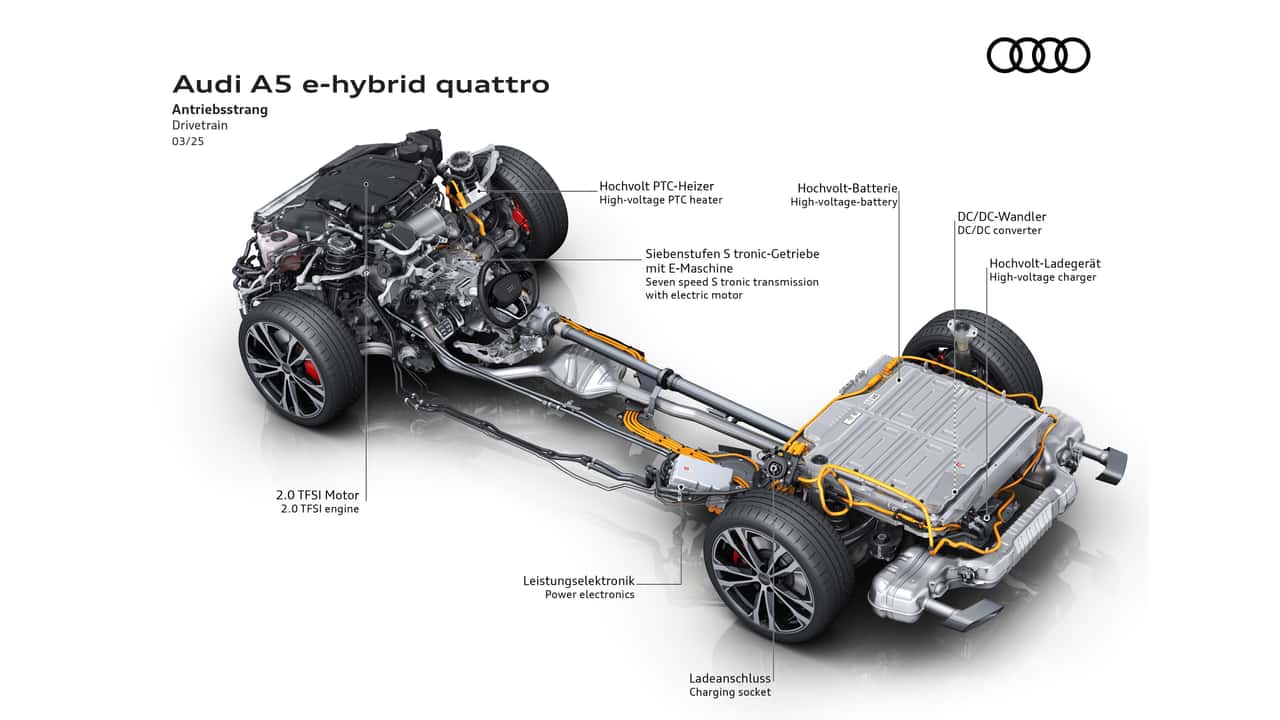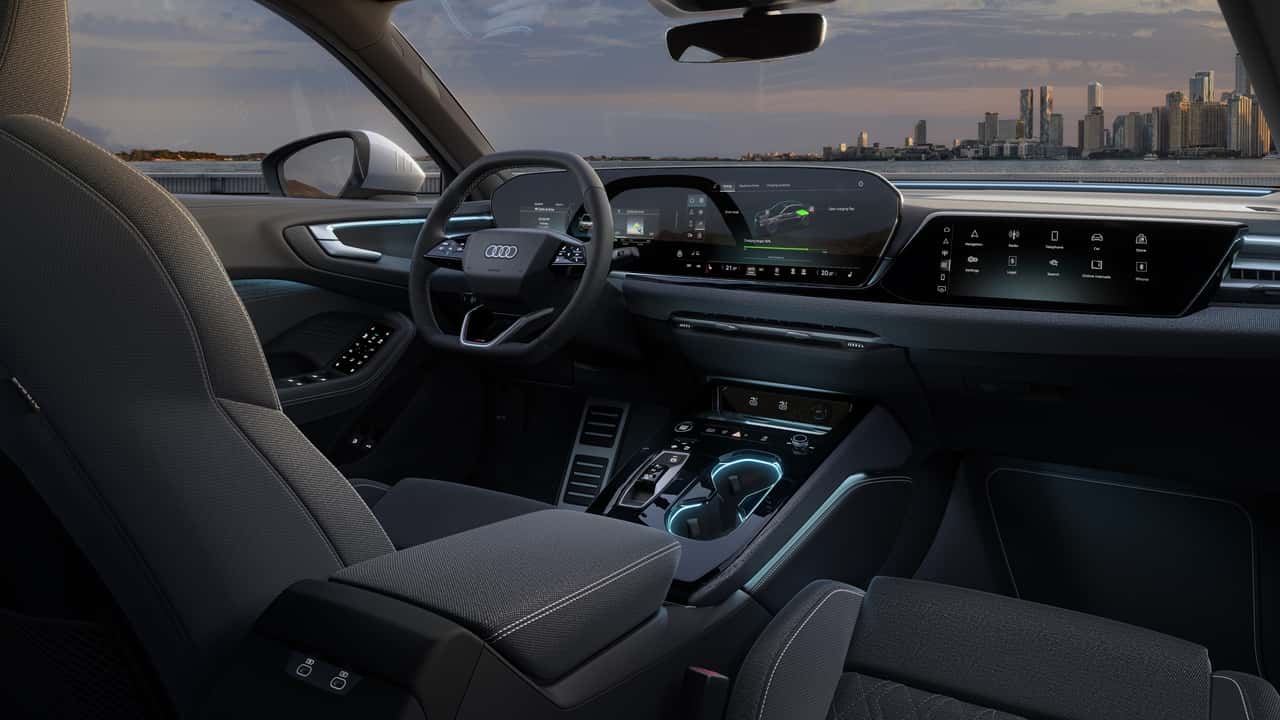Audi A5 Plug-In Hybrid Boasts Larger Battery than First Nissan Leaf

The electric motor is positioned between the gasoline engine and the transmission, allowing for a seven-speed electric vehicle setup at times.
- The latest Audi A5 hybrid has the capability to travel up to 68 miles using only electric power.
- An electric motor is positioned between the 2.0-liter gasoline engine and the seven-speed automatic transmission.
Audi it was evident when it stated that it would invest in plug-in hybrids in the near future Sales of its fully electric vehicles dropped sharply. Last year, and the premium German carmaker isn’t losing any time as it implements its plan.
The latest model of the Audi A5 plug-in hybrid has arrived, known as the A5 e-Hybrid. It follows closely after its smaller counterpart, the A3 PHEV , which was launched last year as one of the longest-range plug-in hybrid electric vehicles (PHEVs) in Europe.
The Audi A5 plug-in hybrid may not lead in electric-only range, yet it remains a solid option for those hesitant about fully adopting an electrified way of life. Actually, the A5’s high-voltage battery capacity surpasses that of the initial Nissan Leaf model—and if this doesn’t highlight the significant advancements in battery tech over the last ten years, nothing else will.
More PHEVs
- Creating a plug-in hybrid vehicle is much more challenging than you might assume.
- The 2025 Mitsubishi Outlander PHEV Lacks This Crucial Upgrade
- Nearly half of Volvo's global sales in 2024 were attributed to EVs and PHEVs.
- Plug-in hybrids have arrived, but potential buyers remain unconvinced.
Just to recap, a plug-in hybrid car relies on both a gasoline engine and an electric motor powered by a high-voltage battery. To put it simply, this complex configuration comes with the drawback of lugging around a hefty battery whenever you use gas for propulsion. Conversely, when operating solely on electricity, you still have the weight of the internal combustion engine to contend with.
Given these points, if charging the battery at home works for you, a plug-in hybrid electric vehicle (PHEV) turns into an excellent option for individuals who prefer not to rely on DC fast chargers, regardless of the reasons behind this preference.
For the Audi A5 e-tron hybrid, you'll find a 2.0-liter gas engine with 248 horsepower beneath the bonnet paired with a seven-speed dual-clutch transmission. The model lineup includes a sedan and a station wagon variant, each equipped with Audi’s signature Quattro all-wheel-drive technology as standard equipment. Furthermore, nestled between the internal combustion engine and the gearbox lies an electric motor.

The electric motor generates up to 140 horsepower, with the total system output ranging from 295 horsepower to 362 horsepower based on the model. Consequently, the strongest variant of the A5 PHEV rivals the performance of the V-6-driven Audi S6. Placing the electric motor between the gasoline engine and the transmission allows drivers to utilize the brand’s Quattro All-Wheel Drive system along with all seven gear ratios when operating solely on electric power.
The zero to 62 miles per hour (0-100 kilometers per hour) sprint is dealt with in 5.1 seconds for the most powerful version, while the 295 hp variant needs 5.9 seconds. Both can reach a top speed of 155 mph (250 kph).
The electric motor is powered by a 20.7-kWh (25.9 kWh gross) lithium-ion battery pack, which allows for an all-electric range of approximately 72 miles (116 kilometers) under city driving conditions based on the WLTP standards. According to Audi, this extends to around 68 miles (110 km) when considering the combinedWLTP cycle. For reference, the initial model of the Nissan Leaf—the pioneering mass-market electric vehicle—came equipped with a 21 kWh (24 kWh gross) battery and offered a driving distance between 70 to 80 miles per charge.

The high-voltage battery of the A5 PHEV can be charged exclusively from an alternating current (AC) power source with a maximum capacity of 11 kW. This represents an improvement over Audi’s earlier models, which were limited to charging rates of up to 7.4 kW. When operated at top efficiency, this new model can achieve a complete charge—from empty to fully powered—at around two and a half hours.
The German car manufacturer mentioned that they put significant effort into optimizing how their new hybrid system functions in practical scenarios. Unlike the older A6 plug-in hybrid, the upcoming A5 PHEV aims to operate predominantly using electric power. Additionally, the updated model allows for greater energy recovery during braking with 88 kW—a step up from its predecessor—and offers several brake regeneration settings.
The vehicle features an auto mode which automatically modifies the regeneration intensity based on navigation details and inputs from the traffic sign recognition technology; however, drivers have the option to manually adjust this setting through paddles located behind the steering wheel, similar to certain electric vehicles. Four recovery modes are available for selection including a level zero where the car coasts upon lifting off the gas pedal.
The Audi A5 e-tron offers both fully electric and hybrid operation modes. Through the vehicle’s entertainment interface, drivers have the option to keep their battery charged at a specific level or utilize the gasoline engine for charging during travel. When employing this method, the electric motor functions solely as a generator above 40 mph (65 km/h). Under full-electric mode, the top speed is capped at 87 mph (140 km/h).
According to the WLTP efficiency figures, the new Audi A5 e-hybrid will get somewhere between 117 and 87 miles per gallon (2.0 - 2.7 liters/100 kilometers) with a full battery. Meanwhile, the weighted combined electric power consumption is between 4.1 and 3.9 miles/kWh (14.9 - 15.9 kWh/100 km). With an empty battery, the fuel economy takes a hit–between 37 and 31 mpg (6.3 - 7.4 l/100 km).
The Audi A5 plug-in hybrid includes a standard electric air conditioning compressor along with a resistive (PTC) heater. As such, the interior can be preheated prior to departure similar to how it works in fully electric vehicles. Additionally, customers have the option of adding a comfort auxiliary air conditioning setup which activates functions including heated seats, ventilated seats, heated steering wheels, and glass pane heaters. The vehicle also comes equipped with a tri-zone automatic climate control system as a standard feature.
The base price for the Audi A5 Sedan e-Hybrid is $67,300 (€62,500), whereas the Avant variant begins at $69,000 (€64,150). For more powerful editions, you'll pay from $76,300 (€70,900) for the sedans and $78,000 (€72,550) for the wagons. Orders can be placed starting today across European markets, with shipments scheduled to commence next month. At this point, there has been no announcement regarding whether the A5 PHEV will reach U.S. dealerships; however, since the older generation of the sedan continues to sell well domestically, it might follow suit. On the other hand, prospects look slim for the arrival of the Avant in America.

Post a Comment for "Audi A5 Plug-In Hybrid Boasts Larger Battery than First Nissan Leaf"